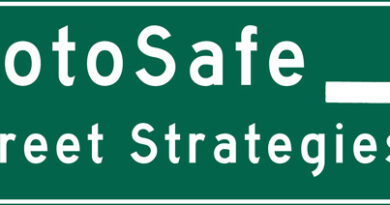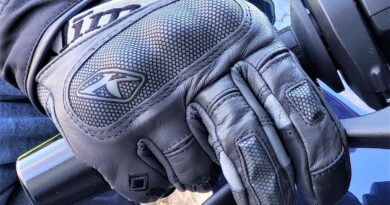Lean on Champ U to build skills in the off season
NOTE: Some Champ U online courses are available to MOA members at a discount! Refer to bmwmoa.org/ChampU for details!
Based at both NCBike in Garysburg, N.C., and Inde Motorsports Ranch in Wilcox, Ariz., Yamaha Champions Riding School rotates through a wide variety of racetrack locations across the country annually with their immersive two-day ChampSchool training program. This highly evolved operation supplies a curated selection of Yamaha motorcycles, premium gear, and videotaping services alongside classroom and on-track instruction by impressively credentialed experts for riders of every skill level, from neophyte to professional racer. Class sizes are extremely small (4:1 ratio of students to instructors) and the days are fully catered. As you’d expect, such a top-shelf experience comes with a hefty price tag: $1,895-$4,000, depending on location. Bike and gear rental is extra, but students can bring their own (all adequately prepped motorcycles are welcome, regardless of genre, but full leathers are required). YCRS also conducts ChampStreet classes wherein students ride their own bikes in the paddock or on a kart track in a one-day format focused on essential street skills at a much lower cost of $495-$595 (non-leather riding gear is allowed). Other offerings are available, including individual instruction and remote review of your submitted video; see ridelikeachampion.com for details.
 Riders preparing for in-person training or looking for instruction available without leaving home can access YCRS curricula via Champ U, a set of online courses containing videos, quizzes, and activities designed to maximize learning at the least possible expense, a mere $99.95 for the Core Curriculum (access is included in the price of in-person tuition). New Rider and ChampBody (rider fitness) courses are available for $19.95 and $69.95, respectively, and a brand-new course, Traffic Survival, is $79.95. Some courses can be bundled at a discount. Given the wealth of high-quality material in each package, those prices represent outrageous values, but as they say in late night TV ads, Wait – there’s more! MOA members can access the Core Curriculum at a greatly reduced cost of $39.95, which can then be covered by a rebate from the MOA Foundation, making it totally free (see bmwmoaf.org for details and special registration link). You don’t have to order before midnight tonight to get this amazing deal, but why wait?
Riders preparing for in-person training or looking for instruction available without leaving home can access YCRS curricula via Champ U, a set of online courses containing videos, quizzes, and activities designed to maximize learning at the least possible expense, a mere $99.95 for the Core Curriculum (access is included in the price of in-person tuition). New Rider and ChampBody (rider fitness) courses are available for $19.95 and $69.95, respectively, and a brand-new course, Traffic Survival, is $79.95. Some courses can be bundled at a discount. Given the wealth of high-quality material in each package, those prices represent outrageous values, but as they say in late night TV ads, Wait – there’s more! MOA members can access the Core Curriculum at a greatly reduced cost of $39.95, which can then be covered by a rebate from the MOA Foundation, making it totally free (see bmwmoaf.org for details and special registration link). You don’t have to order before midnight tonight to get this amazing deal, but why wait?
Before we get into additional details about ChampU, here’s some background on YCRS. Founded by CEO and Lead Instructor Nick Ienatsch in 2008, the name’s reference to “Champions” isn’t just a hook to attract students who want to think of themselves as such, or even win real championships. It’s part of an overarching philosophy that riders at the very peak of skill development are the best equipped to teach riding skills, not because all students aspire to road racing greatness, but because a) motorcycles are developed by expert riders and function best at any speed and in any context when operated using the same techniques those expert riders used, and b) there’s a convergence at the top of the expertise pyramid, with the very best riders using very similar methods, whereas less advanced motorcyclists employ a broader range of approaches with less overall efficacy.
The core team of YCRS instructors have demonstrated unquestionable technical mastery by establishing themselves as bona fide champions in the crucible of officially sanctioned competition. Their “Champion” status is an objectively verifiable matter of public record, not someone’s opinion. Ienatsch, whom you probably recognize as a long-time motojournalist (he has written extensively for Motorcyclist, Sport Rider, and Cycle World since 1984), has multiple national #1 plates of his own, and taught for 12 years at Freddie Spencer’s High Performance Riding School. He’s an extraordinarily articulate communicator with the analytic mind of an engineer, all readily apparent in the clarity, precision and conciseness of the curricula he has developed for YCRS in collaboration with his crew. Ienatsch has a passion for teaching and understands how to engage the hearts and minds of students at any level of competence. He has been careful to select only those instructors who can do likewise. Subject matter expertise doesn’t necessarily come with the necessary attitude and skill set for effective teaching, so Ienatsch’s sense of mission and prioritization of customer service have driven him to ensure each member of his staff has the complete package. (Hear my in-depth interview with Nick Ienatsch on The Ride Inside podcast, available at bmwownersnews.com.)

An example of YCRS’s excellence in teaching is their distillation of numerous riding essentials down to four core Champion Habits. (Spoiler alert – er, non-spoiler alert: I’ll not list them here because I want you to check out the curricula for yourself!) These are pithy phrases that capture action-oriented concepts fundamental to good riding at any speed, in any setting. Based on the principle that technical proficiency is an indispensable requirement for both safety and enjoyment, the Habits permeate YCRS’s entire curricula. Everything comes down to a conviction there’s a path forward for any rider desiring to improve: learning specific, concrete, demonstrable “best practices” invariably results in better performance, with the associated benefits of greater safety and more fun, whether riding casually on the street or pursuing trophies at the track.
Be forewarned, these best techniques will likely conflict with some – maybe much – of what you’ve been taught by other riders, and perhaps even other rider training programs/instructors of lesser sophistication. At YCRS, “best” is what has been proven at the pinnacle of competition, not what might arise from someone’s theory or a popular notion. These teachings will undoubtedly differ from what the average rider figures out by trial-and-error without the benefit of rigorous testing in the unforgiving laboratory of the racetrack. The good news is no one has to reinvent the wheel. The knowledge gleaned by genuine champions can be taught, saving students immeasurable amounts of time and the painful costs (physical and financial) of needless mistakes. While there are details of special interest to racers and certain techniques advisable only in a closed-circuit setting, the same foundational principles of motorcycle control apply to riding at all levels. All the expected subject matter is present – counter-steering, braking, shifting, traction management, lean angle, body position, etc. – along with less commonly discussed topics, like strategic suspension loading/unloading. Even the familiar areas likely contain new-to-you info with serious implications for your non-champ habits.

Just in case you still think racer wisdom isn’t relevant to riding on the street, consider this: The YCRS approach is intentionally designed to grow the riding community (obviously comprised of mostly non-racers) and keep its members from departing the fold as a result of injury or death. The two leading causes of riding disasters are a) collisions at intersections, especially unmanaged ones (e.g., driveways and parking lot exits), and b) riders running wide in corners (into oncoming traffic or off the pavement). YCRS courses are aimed at minimizing the likelihood of these specific events with strategies and actions that greatly enhance control in real-world emergencies most riders consider a function of “bad luck.” YCRS has identified the seven most common reasons riders crash (anywhere), and these problematic practices – yes, they are attributable to rider error, not just happenstance – are addressed repeatedly throughout the training.
YCRS’s ChampSchool is impractical for many riders due to its expense, distance, and concentrated time commitment, so Ienatsch & company launched ChampU as an alternative in 2021, hoping to get their message out to a broader audience. It has since evolved rapidly and is currently comprised of the four courses already noted. Each of these is well organized into readily digestible bite-sized pieces – topical modules further subdivided into lessons that typically include a 3- to 8-minute video containing explanations and demonstrations, followed by brief (and often amusing) quizzes to promote attentiveness. Students must pass each quiz with 70% correct to advance to the next lesson, but this is easy to do by simply paying attention during the lesson and reading the questions and answers carefully and completely; the first rule of YCRS is Focus! You can always re-take the quizzes if necessary, and the reasons for correct/incorrect rulings are clearly explained. Many modules also contain drills and exercises designed to provide the vitally important experiential reference points that make abstract concepts meaningful and useful in actual practice. As you’d expect, the vast majority of these are performed with a motorcycle, but some can be done in your car/truck/van, some on a bicycle, and some simply involve your own body. Those utilizing your motorcycle don’t necessarily require it to be moving or running, so you can do some practicing in the confines of your garage. One example of this is developing subtlety in brake lever operation by feeling the drag created by very slight application as you walk your bike across the floor. It’s imperative students go through the lessons at a pace that allows completing these activities. Even if you’re able to memorize the enormous quantity of information presented, it will be of terribly limited value in real-world situations demanding reflexive responses; those can only be developed through repetitive physical action, regardless of intellectual understanding.
Another illustration from the Core Curriculum I found brilliantly illuminating was a demonstration of tire traction, specifically the stark contrast between steady and abrupt demands. While I’ve been aware of this principle for a long time, it was still powerful to watch as an instructor tilted an upright tire, stepped away from it while leaning on it, and showed how the tire’s contact patch spread and gripped in a way that looked impossible (I’d have guessed it wouldn’t support his weight like that). He then knocked the tire with the heel of his hand, creating little spikes of pressure that easily overwhelmed the tire’s traction and sent it skittering under much less load than it had withstood at a constant level. Such immediately compelling demonstrations aren’t possible with still photos in a book or on a webpage, or with words alone.
The Core Curriculum course (13 modules/52 lessons) is the most comprehensive of the four, but the latest addition – Traffic Survival (6 modules/43 lessons) – is also a must for riders who want to hone their accident avoidance skills and learn how best to navigate perils specific to the street (Core Curriculum is a prerequisite for enrollment). It covers psychological and behavioral aspects that build upon basic technical competence to help riders stay unhurt, even when they’re unseen. Fans of David Hough’s Proficient Motorcycling series will find some familiar tactics presented in fresh ways here, elaborated with the benefits of videography and integrated with the teachings from the Core Curriculum. There’s also much in Traffic Survival that picks up where Hough’s writings left off, advancing street safety to a higher plane; it’s not just a repeat. The New Rider course (9 modules/56 lessons) is self-explanatory, but it bears noting that even this most basic option emphasizes the same fundamental principles and practices contained in the others, albeit in a way especially accessible and relevant to those entering the riding world for the first time or returning after a lengthy hiatus.

Finally, ChampBody (10 modules/53 lessons) is based on the belief motorcycling is 95% mental and… 95% physical (gotcha!). Riders with deficits in flexibility, strength, stamina, nutrition, hydration, rest, etc. are going to experience significant limitations in their ability to execute skills they may fully understand and otherwise be perfectly able to perform. If your neck lacks range of motion, your pre-lane-change head-checks will suffer. If certain muscle groups are weak, you’ll put too much weight on the bars, interfering with dexterity and stability, and resulting in shoulder/arm/wrist/hand fatigue. If you’re unaware of proper body positioning or how you’re not really achieving it, you’ll miscommunicate your intentions to your bike, causing it to behave differently than you want. And if your endurance is poor, you’ll have to end rides early or push yourself beyond the point of compromised mental and physical capabilities, and you’ll feel sore and wrung out afterward. ChampBody focuses on functional fitness to facilitate skillful and comfortable riding. It won’t turn you into a bodybuilder, yogi, or marathoner, but it will make motorcycling easier to do well.
All ChampU courses include access to a student discussion forum where instructors answer questions and provide clarifications. It’s set up to be mobile-friendly, so you can refer to lessons while out practicing, and even make notes on-screen. The Core Curriculum course’s completion certificate may qualify you for a discount on your insurance, too.
I’ve taken a dozen rider training courses in-person, most of which were held at racetracks. The typical schedule includes 20 minutes of classroom instruction and 20 minutes of track time each hour, with the remaining 20 minutes spent transitioning and tending to hydration and “de-hydration” (full bladder, anyone?). In two seven-hour days, that means getting a total of 4.5 hours of didactic education during a weekend course. Actually, it’d be more, since you wouldn’t get seven track outings per day – that would exceed virtually all attendees’ stamina, regardless of their enthusiasm! But let’s say there are 4.5 hours of classroom presentation with the additional time spent in discussion and Q&A. ChampU’s Core Curriculum, with its 52 lessons averaging five minutes each, also totals 4.5 hours (not counting time spent on quizzes, drills, and exercises). So, YCRS’s claim it delivers much the same teaching you’d receive in-person at a two-day ChampSchool seems credible. True, you won’t be lapping a racetrack in between lectures and getting personalized feedback, but you also won’t have to fly/drive hours to get there, block out a weekend plus travel time, and spend thousands of dollars. You can watch and practice as your schedule allows, and review lessons again and again, indefinitely, at no additional cost. Like I said earlier, this is an outrageous value at full price, and MOA members who don’t take advantage of it FOR FREE, are taking an outrageous – and completely unnecessary – loss.
C’mon, be a Champ, not a chump!



